FluWatch report: September 8 to 21, 2019 (weeks 37 and 38)
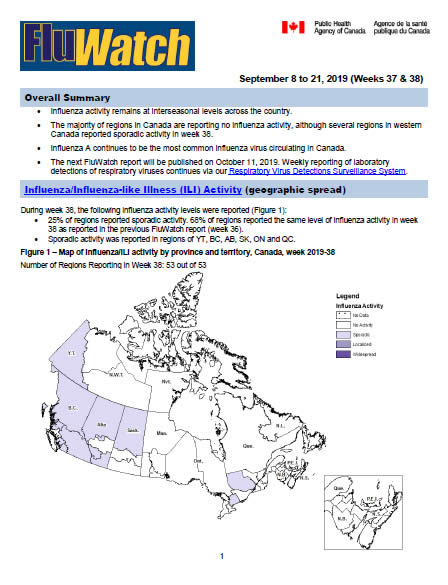
Download the alternative format
(PDF format, 977 KB, 10 pages)
Organization: Public Health Agency of Canada
Date published: 2019-09-27
Related Topics
Overall Summary
- Influenza activity remains at interseasonal levels across the country.
- The majority of regions in Canada are reporting no influenza activity, although several regions in western Canada reported sporadic activity in week 38.
- Influenza A continues to be the most common influenza virus circulating in Canada.
- The next FluWatch report will be published on October 11, 2019. Weekly reporting of laboratory detections of respiratory viruses continues via our Respiratory Virus Detections Surveillance System.
On this page
- Influenza/ILI Activity (geographic spread)
- Laboratory Confirmed Influenza Detections
- Syndromic/Influenza-like Illness Surveillance
- Participatory Syndromic Surveillance
- Influenza Outbreak Surveillance
- Severe Outcomes Influenza Surveillance
- Influenza Strain Characterizations
- Antiviral Resistance
- Vaccine Monitoring
- Provincial and International Influenza Reports
Influenza/Influenza-like Illness Activity (geographic spread)
During week 38, the following influenza activity levels were reported (Figure 1):
- 25% of regions reported sporadic activity. 68% of regions reported the same level of influenza activity in week 38 as reported in the previous FluWatch report (week 36).
- Sporadic activity was reported in regions of YT, BC, AB, SK, ON and QC.
Figure 1 – Map of overall influenza/ILI activity by province and territory, Canada, week 2019-38
Number of Regions Reporting in Week 38: 53 out of 53
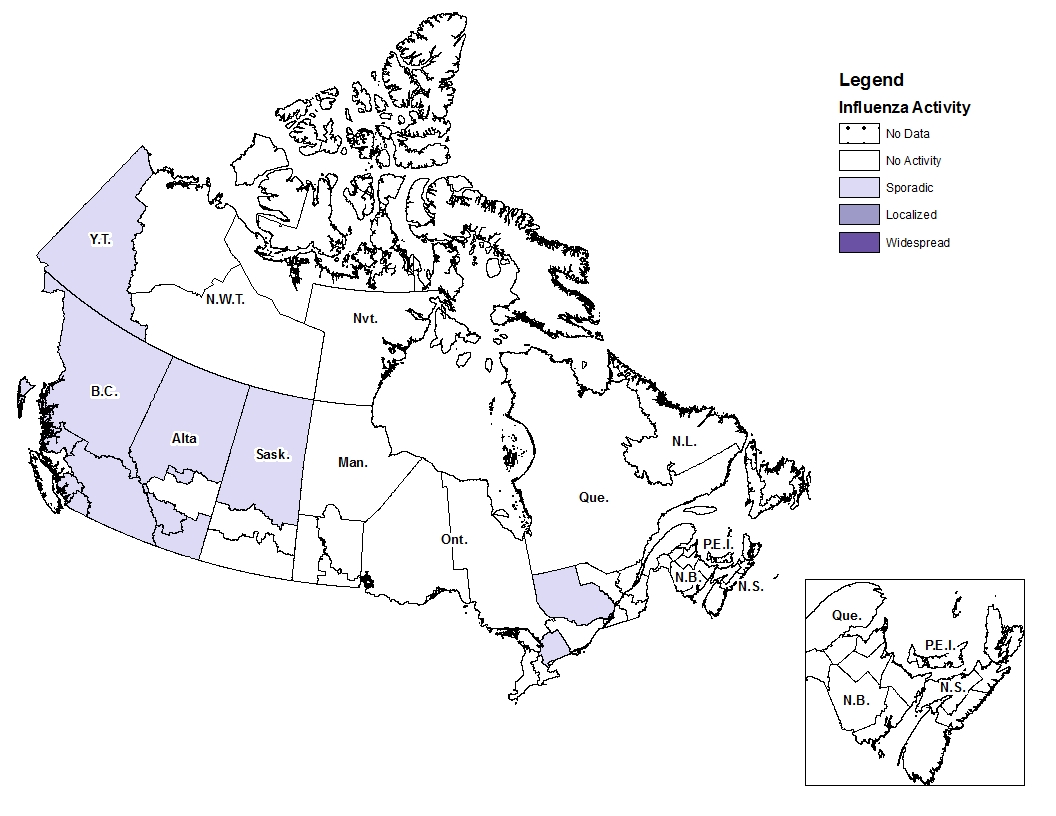
Figure 1 - Text equivalent
| Province | Influenza Surveillance Region | Activity Level |
|---|---|---|
| N.L. | Eastern | No Activity |
| N.L. | Labrador-Grenfell | No Activity |
| N.L. | Central | No Activity |
| N.L. | Western | No Activity |
| P.E.I. | Prince Edward Island | No Activity |
| N.S. | Zone 1 - Western | No Activity |
| N.S. | Zone 2 - Northern | No Activity |
| N.S. | Zone 3 - Eastern | No Activity |
| N.S. | Zone 4 - Central | No Activity |
| N.B. | Region 1 | No Activity |
| N.B. | Region 2 | No Activity |
| N.B. | Region 3 | No Activity |
| N.B. | Region 4 | No Activity |
| N.B. | Region 5 | No Activity |
| N.B. | Region 6 | No Activity |
| N.B. | Region 7 | No Activity |
| Que. | Nord-est | No Activity |
| Que. | Québec et Chaudieres-Appalaches | No Activity |
| Que. | Centre-du-Québec | No Activity |
| Que. | Montréal et Laval | Sporadic |
| Que. | Ouest-du-Québec | Sporadic |
| Que. | Montérégie | No Activity |
| Ont. | Central East | No Activity |
| Ont. | Central West | No Activity |
| Ont. | Eastern | No Activity |
| Ont. | North East | No Activity |
| Ont. | North West | No Activity |
| Ont. | South West | Sporadic |
| Ont. | Toronto | No Activity |
| Man. | Northern Regional | No Activity |
| Man. | Prairie Mountain | No Activity |
| Man. | Interlake-Eastern | No Activity |
| Man. | Winnipeg | No Activity |
| Man. | Southern Health | No Activity |
| Sask. | North | No Activity |
| Sask. | Central | No Activity |
| Sask. | South | Sporadic |
| Alta. | North Zone | Sporadic |
| Alta. | Edmonton | Sporadic |
| Alta. | Central Zone | No Activity |
| Alta. | Calgary | Sporadic |
| Alta. | South Zone | Sporadic |
| B.C. | Interior | Sporadic |
| B.C. | Fraser | Sporadic |
| B.C. | Vancouver Coastal | Sporadic |
| B.C. | Vancouver Island | No Activity |
| B.C. | Northern | Sporadic |
| Y.T. | Yukon | Sporadic |
| N.W.T. | North | No Activity |
| N.W.T. | South | No Activity |
| Nvt. | Qikiqtaaluk | No Activity |
| Nvt. | Kivalliq | No Activity |
| Nvt. | Kitimeot | No Activity |
Laboratory-Confirmed Influenza Detections
In weeks 37 and 38, the following results were reported from sentinel laboratories across Canada (Figures 2 and 3):
- A total of 61 laboratory detections of influenza were reported, of which 82% (50) were influenza A.
- The percentage of tests positive for influenza was 1.1% in weeks 37 and 38. This is similar to the percentage observed since mid-July (weeks 29-36).
- Influenza A(H3N2) accounted for 85% (28 of 33) subtyped influenza A detections during this 2-week period. This is similar to the percentage observed since mid-July (weeks 29-36).
To date this season (weeks 35 to 38), detailed information on age and type/subtype has been received for 77 laboratory-confirmed influenza cases: 66 (86%) influenza A and 11 (14%) influenza B. Among subtyped influenza A detections, 88% of cases were A(H3N2).
For more detailed weekly and cumulative influenza data, see the text descriptions for Figures 2 and 3 or the Respiratory Virus Detections in Canada Report.
Figure 2 – Number of positive influenza tests and percentage of tests positive, by type, subtype and report week, Canada, weeks 2019-35 to 2019-38
Number of Laboratories Reporting in Week 38: 35 out of 36
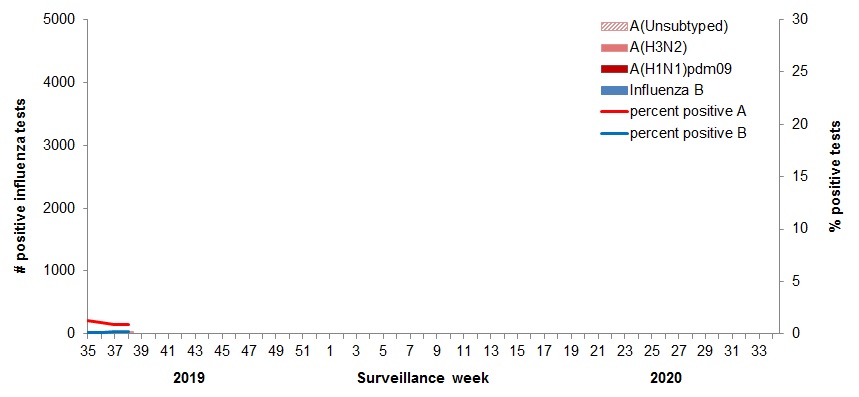
Figure 2 - Text equivalent
| Surveillance Week | A(Unsubtyped) | A(H3N2) | A(H1N1)pdm09 | Influenza B | Percent Positive A | Percent Positive B |
|---|---|---|---|---|---|---|
| 35 | 10 | 16 | 0 | 2 | 1.3 | 0.1 |
| 36 | 11 | 13 | 2 | 2 | 1.1 | 0.1 |
| 37 | 5 | 17 | 2 | 5 | 0.9 | 0.2 |
| 38 | 12 | 11 | 3 | 6 | 0.9 | 0.2 |
Figure 3 – Distribution of positive influenza specimens by type/subtype and province/territory*, Canada, weeks 2019-35 to 2019-38
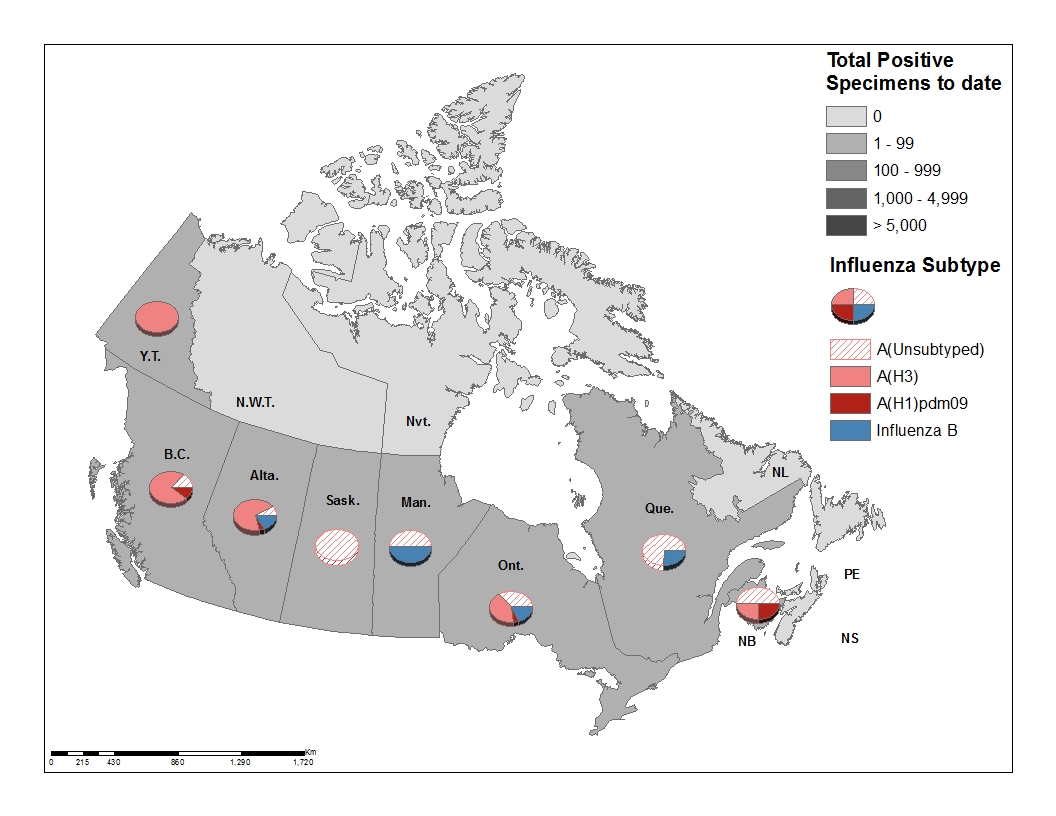
Figure 3 - Text equivalent
| Reporting provincesTable Figure 3 - Footnote 1 | Cumulative (August 25, 2019 to September 21, 2019) | |||||
|---|---|---|---|---|---|---|
| A Total | A(H1N1)pdm09 | A(H3N2) | A(UnS)3 | B Total | A & B Total | |
| BC | 37 | 4 | 28 | 5 | 0 | 37 |
| AB | 20 | 1 | 17 | 2 | 4 | 24 |
| SK | 3 | 0 | 0 | 3 | 0 | 3 |
| MB | 1 | 0 | 0 | 1 | 1 | 2 |
| ON | 18 | 1 | 9 | 8 | 4 | 22 |
| QC | 17 | 0 | 0 | 17 | 6 | 23 |
| NB | 4 | 1 | 1 | 2 | 0 | 4 |
| NS | 0 | 0 | 0 | 0 | 0 | 0 |
| PEI | 0 | 0 | 0 | 0 | 0 | 0 |
| NL | 0 | 0 | 0 | 0 | 0 | 0 |
| YT | 2 | 0 | 2 | 0 | 0 | 2 |
| N.W.T | 0 | 0 | 0 | 0 | 0 | 0 |
| NU | 0 | 0 | 0 | 0 | 0 | 0 |
| Canada | 102 | 7 | 57 | 38 | 15 | 117 |
| PercentageTable Figure 3 - Footnote 2 | 87% | 7% | 56% | 37% | 13% | 100% |
|
||||||
Syndromic / Influenza-like Illness Surveillance
Healthcare Professionals Sentinel Syndromic Surveillance
In week 37, 0.8% and in week 38, 1.7%, of visits to healthcare professionals were due to influenza-like illness (ILI) (Figure 4). In week 38, 53% of reporting sentinel practitioners were in BC and AB, where sporadic influenza activity has been reported. These sentinels contributed 58% of the ILI cases reported this week.
Figure 4 – Percentage of visits for ILI reported by sentinels by report week, Canada, weeks 2019-35 to 2019-38
Number of Sentinels Reporting in Week 38: 72
Average weekly number of reporting sentinels (2018-19 season): 106
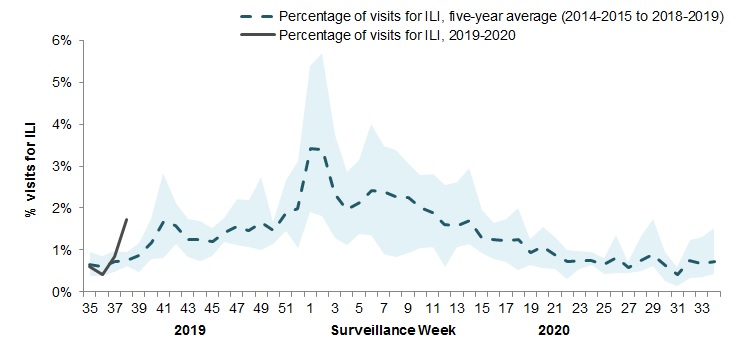
The shaded area represents the maximum and minimum percentage of visits for ILI reported by week from seasons 2014-2015 to 2018-2019
Figure 4 - Text equivalent
| Surveillance Week | 2019-20 | Average | Min | Max |
|---|---|---|---|---|
| 35 | 0.6% | 0.6% | 0.4% | 0.9% |
| 36 | 0.4% | 0.6% | 0.4% | 0.9% |
| 37 | 0.8% | 0.7% | 0.5% | 1.0% |
| 38 | 1.7% | 0.7% | 0.6% | 1.0% |
| 39 | 0.9% | 0.5% | 1.2% | |
| 40 | 1.2% | 0.8% | 1.7% | |
| 41 | 1.7% | 0.8% | 2.8% | |
| 42 | 1.6% | 1.2% | 2.1% | |
| 43 | 1.2% | 0.8% | 1.7% | |
| 44 | 1.2% | 0.7% | 1.7% | |
| 45 | 1.2% | 0.9% | 1.5% | |
| 46 | 1.4% | 1.2% | 1.8% | |
| 47 | 1.6% | 1.1% | 2.2% | |
| 48 | 1.5% | 1.1% | 2.2% | |
| 49 | 1.7% | 1.0% | 2.8% | |
| 50 | 1.5% | 1.1% | 1.7% | |
| 51 | 1.9% | 1.4% | 2.7% | |
| 52 | 2.0% | 1.0% | 3.1% | |
| 1 | 3.4% | 1.9% | 5.4% | |
| 2 | 3.4% | 1.8% | 5.7% | |
| 3 | 2.3% | 1.3% | 3.7% | |
| 4 | 2.0% | 1.1% | 2.9% | |
| 5 | 2.1% | 1.4% | 3.1% | |
| 6 | 2.4% | 1.4% | 4.0% | |
| 7 | 2.4% | 0.9% | 3.5% | |
| 8 | 2.3% | 0.8% | 3.4% | |
| 9 | 2.3% | 0.9% | 3.1% | |
| 10 | 2.0% | 1.0% | 2.8% | |
| 11 | 1.9% | 1.1% | 2.8% | |
| 12 | 1.6% | 0.6% | 2.6% | |
| 13 | 1.6% | 1.1% | 2.6% | |
| 14 | 1.7% | 1.1% | 3.0% | |
| 15 | 1.3% | 0.9% | 1.9% | |
| 16 | 1.2% | 0.8% | 1.7% | |
| 17 | 1.2% | 0.7% | 1.7% | |
| 18 | 1.3% | 0.5% | 2.0% | |
| 19 | 0.9% | 0.6% | 1.3% | |
| 20 | 1.1% | 0.6% | 1.5% | |
| 21 | 0.9% | 0.5% | 1.3% | |
| 22 | 0.7% | 0.3% | 1.0% | |
| 23 | 0.8% | 0.6% | 1.0% | |
| 24 | 0.7% | 0.6% | 1.0% | |
| 25 | 0.6% | 0.4% | 0.8% | |
| 26 | 0.8% | 0.5% | 1.4% | |
| 27 | 0.6% | 0.5% | 0.7% | |
| 28 | 0.7% | 0.5% | 1.3% | |
| 29 | 0.9% | 0.6% | 1.7% | |
| 30 | 0.6% | 0.2% | 0.9% | |
| 31 | 0.4% | 0.2% | 0.6% | |
| 32 | 0.8% | 0.3% | 1.2% | |
| 33 | 0.7% | 0.4% | 1.3% | |
| 34 | 0.7% | 0.4% | 1.5% |
FluWatchers
FluWatchers is a participatory ILI surveillance system that relies on weekly voluntary submissions of syndromic information from Canadians across Canada. Click here to learn more about the FluWatchers program.
If you are interested in becoming a FluWatcher for this season, sign up today.
FluWatchers reporting for the 2019-20 season will begin October 7th, 2019 (collecting data for week 40).
Influenza Outbreak Surveillance
In weeks 37 and 38, no laboratory-confirmed influenza outbreaks nor ILI outbreaks were reported.
Number of provinces and territories reporting in weeks 37 and 38: 13 out of 13
Severe Outcomes Influenza Surveillance
Provincial/Territorial Influenza Hospitalizations and Deaths
In weeks 37 and 38 less than five influenza-associated hospitalizations were reported by participating provinces and territoriesFootnote 1.
To date this season, 6 influenza-associated hospitalizations were reported by participating provinces and territoriesFootnote 1. All cases were associated with influenza A. No ICU admissions or deaths were reported.
Number of provinces and territories reporting in weeks 37 and 38: 9 out of 9
- Footnote 1
-
Influenza-associated hospitalizations are reported by N.L., P.E.I, N.S., N.B., Man., Alb., Y.T. and N.W.T. Only hospitalizations that require intensive medical care are reported by Sask. The cumulative rate of hospitalizations is calculated using the population by age-group in participating provinces and territories.
Pediatric Influenza Hospitalizations and Deaths
In weeks 37 and 38, no new pediatric (≤16 years of age) hospitalizations with influenza were reported by the Immunization Monitoring Program Active (IMPACT) network.
To date this season, fewer than five pediatric hospitalizations were reported by the IMPACT network.
Adult Influenza Hospitalizations and Deaths
Surveillance of laboratory-confirmed influenza-associated adult (≥16 years of age) hospitalizations by the Canadian Immunization Research Network (CIRN) Serious Outcomes Surveillance (SOS) network has not yet begun for the 2019-20 season.
Influenza Strain Characterizations
The National Microbiology Laboratory has not yet reported influenza strain characterization results for influenza viruses collected during the 2019-20 season.
Antiviral Resistance
The National Microbiology Laboratory has not yet reported antiviral resistance results for influenza viruses collected during the 2019-20 season.
Vaccine Monitoring
Vaccine monitoring refers to activities related to the monitoring of influenza vaccine coverage and effectiveness.
Vaccine Coverage
Influenza vaccine coverage estimates for the 2019-20 season are anticipated to be available in February or March 2020.
Vaccine Effectiveness
Influenza vaccine effectiveness estimates for the 2019-20 season are anticipated to be available in February or March 2020.